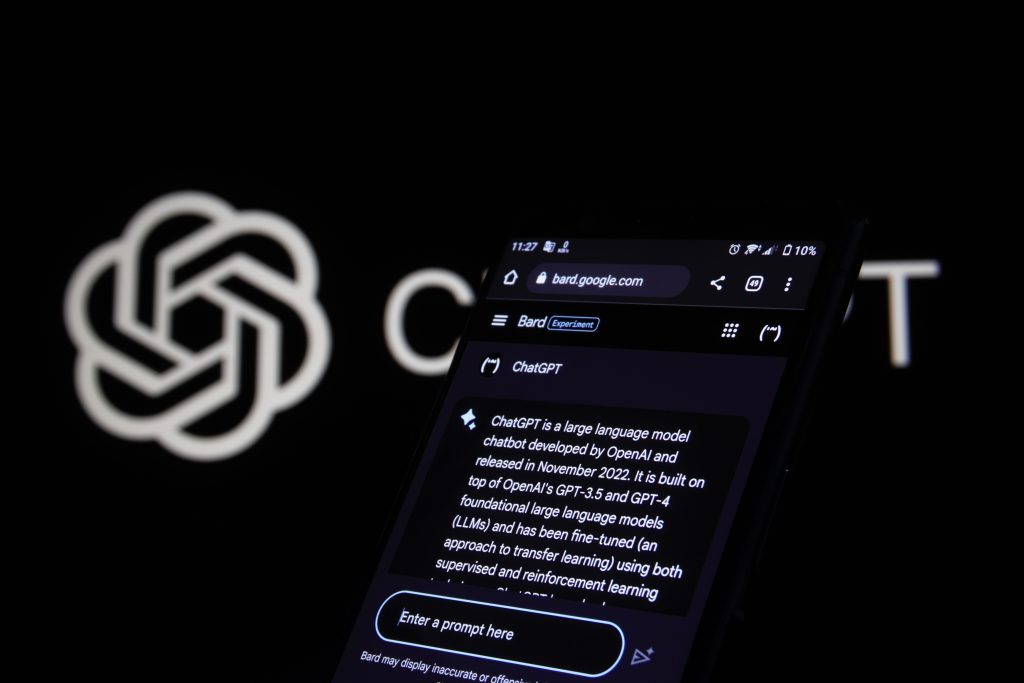 In the past few months, we have spoken to many instructors – faculty, graduate students, even undergraduate teaching assistants – who are doing very interesting things with artificial intelligence tools in their classes this coming fall. Some are writing grants to support research into classroom uses of AI, some are designing interactive online modules to help teach about the ethics of AI, and some are integrating AI tools into their instructional activities.
In the past few months, we have spoken to many instructors – faculty, graduate students, even undergraduate teaching assistants – who are doing very interesting things with artificial intelligence tools in their classes this coming fall. Some are writing grants to support research into classroom uses of AI, some are designing interactive online modules to help teach about the ethics of AI, and some are integrating AI tools into their instructional activities.
This blog post is for another instructor population: those that have not had the time or capacity to redevelop their courses, their assessments, or their activities to accommodate an AI world. “Redesigning assessments with AI in mind” might be the 20th item on a long list of to-dos for the coming semester. Adapting to new technologies that could change the classroom experience – and AI is certainly one of them – seems like an overwhelming task. Classes start in one week, and wrestling with the teaching and learning opportunities and challenges of artificial intelligence may not be an achievable goal.
However, there are some concrete steps and curated resources to take into account in terms of AI when planning and teaching your courses.
Recommendations for Starting with AI
Here are six recommendations (and one extra credit assignment). Following all of these suggestions will put you on good footing with the learning curve associated with AI in the classroom, but even doing one or two is a good way to start.
- Experiment with ChatGPT and other AI tools. Just get in there and start using them and see what they produce. In an article for the Chronicle of Higher Education, one writer said, “I started by reminding myself, anytime I was about to Google something, to ask ChatGPT.”[1] ChatGPT-ing (or using Google Bard) instead of Google-ing is a good on-ramp to AI usage. You may even find them useful to you as an instructor. Here are four basic generative AI models to start with along with prompt suggestions:
- ChatGPT – The first (and by some reports, still the most accurate) text-based generative AI. Prompt suggestion: Ask a basic question about teaching, e.g., “How can I grade exams more efficiently?” or “How can I provide written feedback more efficiently?”
- Google Bard – Less text-heavy than ChatGPT; potentially geared towards more logic-based questions, e.g., “How do I create a website in WordPress?”
- Microsoft Bing – Able to generate images as well as text and simultaneously harness the power of a search engine. Potential question: “Name the characteristics of neo-classical architecture and provide an example.”
- Fotor.com – Image-generator AI. Potential question: “Provide an illustration for my chemistry class syllabus.”
- Run your assignments through an AI tool. This will help benchmark possible AI-generated responses to your assignments. More sophisticated AI users will engage in prompt engineering that could make uncited or incorrect usage of AI harder to detect, but getting at least one example of an AI response is helpful.
 It will not only provide a sightline into possible academic integrity issues but also point to whether your assignment may need to be revised or redeveloped, which could include integrating AI itself. Derek Bruff, a writer and higher education consultant, provides good guidance on assessment design in light of AI:
It will not only provide a sightline into possible academic integrity issues but also point to whether your assignment may need to be revised or redeveloped, which could include integrating AI itself. Derek Bruff, a writer and higher education consultant, provides good guidance on assessment design in light of AI:
- Why does this assignment make sense for this course?
- What are specific learning objectives for this assignment?
- How might students use AI tools while working on this assignment?
- How might AI undercut the goals of this assignment? How could you mitigate this?
- How might AI enhance the assignment? Where would students need help figuring that out?
- Focus on the process. How could you make the assignment more meaningful for students or support them more in the work? [2]
- Add an AI policy to your syllabus. This may require doing some or all of the recommendations above, but even if you do not have the capacity to take a deep dive into AI tools before courses start, it is a good idea to take a stab at a policy, even if it is brief. As mentioned above, you will be adapting this policy fairly quickly. The sooner you develop a benchmark policy and determine what works and what does not, the better. Lance Eaton, a doctoral student in higher education at the University of Massachusetts at Boston, has crowdsourced a Google Document with many helpful examples of AI policies for syllabi. This is an excellent place to start.
- Determine your academic integrity policy for AI. This may be part of your general AI policy or it could be separate. Regardless, this will probably be V.1 of your academic integrity policy, but again, starting now will put you in a good position to iterate as needed. To start, review Academic Integrity Policies for Johns Hopkins Schools. Lance Eaton’s Google Document (above) has many examples of AI policies that include academic integrity statements.
- Teach your students how to cite AI tools. This information could be incorporated into a syllabus policy and/or academic integrity policy, but correct citation – at least according to August 2023 recommendations of these style guides – is step number one. Making your students aware that they need to cite uses of AI tools and giving them the tools for doing that will (hopefully) incentivize compliance with your academic integrity policies.
- Talk to your local center for teaching and learning. All Hopkins Schools have teaching and learning centers, some have been publishing guidance on how to teach and learn with artificial intelligence tools, and many have been considering the possible consequences of AI in the classroom. Here’s a list of teaching and learning centers at Hopkins, and here are two rich resources developed by two CTLs at Hopkins:
- Teaching & Learning in the ChatGPT Era. This website was created by the Center for Learning Design & Technology at the Whiting School of Engineering. It provides a great overview on generative AI as well as providing guidance on academic integrity questions, student use of AI, and assessment design with AI. Kelly Orr, Nathan Graham, Olysha Magruder, Mel Rizzuto, and Edward Queen of the CLDT all contributed to the website as did adjunct faculty David Porter.
- Johns Hopkins University Generative AI Tool Implementation Guidance and Best Practices. Jun Fang, Assistant Director in Teaching & Learning@Carey in the Carey School of Business led the development of this resource with contributions from representatives at other schools and teaching and learning centers at Hopkins. This guide provides substantial guidance on using generative AI to design engaging course activities, provide assignment feedback, and gives a list of AI tools for higher education.
Extra credit assignment for those with a little more capacity:
- Learn a little about prompt engineering. Prompt engineering is developing and refining questions and statements for AI models such that they generate results with the desired specificity, tone, length, citations, etc. This will give you a sightline into AI capacities beyond a simple one-time command (e.g., “Compare and contrast models of femininity in Shakespeare’s Much Ado About Nothing and Taming of the Shrew”) which may yield an overly broad answer that lacks specificity and nuance. Prompt engineering will also help you learn to direct and guide AI models and not just react to them. For a useful beginner’s guide to prompt engineering, check out the brief video on prompting AI from Wharton School instructors.
Why You Should Do This
Here is why you should take the (small) leap: Artificial intelligence will change the way we teach and learn. The internet did this, email did this, and so will AI.  Taking small steps to acculturate to this new reality is the best way to build the flexibility needed to successfully teach and learn with AI – and, very importantly, teach your students how to teach and learn with AI. Here are more reasons to begin to shift your behavior:
Taking small steps to acculturate to this new reality is the best way to build the flexibility needed to successfully teach and learn with AI – and, very importantly, teach your students how to teach and learn with AI. Here are more reasons to begin to shift your behavior:
- You can start small. Take this semester as an opportunity to begin to build your AI teaching and learning skills. You do not have to overhaul your syllabi or classroom activities to accommodate AI; you just have to begin to think through the implications of teaching in a world where AI tools are easily available and could pass your homework assignments. Ask yourself how you would coach students encountering your subject matter for the first time, and then apply those principles to your own learning about AI.
- You will have to learn to adapt quickly. Artificial intelligence tools are evolving rapidly; your course design and instructional approach will do so, too. Each semester will require additional revisions to your syllabi to accommodate our increasing use of AI tools and AI’s increasing capacities. Starting to build those muscles now with lower-effort activities will pay off in the long run.
- You actually know how to do this. Researching? Developing hypotheses? Evaluating resources? Check, check, and check. Iterating, revising, and adapting as you go along? Teaching students how to evaluate resources? Guiding students to think about the definitions of “artificial,” “intelligence,” and “human”? Check all that, too. The skills required to become AI-literate from a teaching and learning perspective are skills you already have. It is just a matter of applying them to this particular challenge/opportunity/problem (however you frame it).
Finally, give yourself and your students some grace. This is a huge part of beginning to learn how to teach and learn in an AI world; most likely, neither you nor your students will be proficient AI practitioners this semester. You may miss an academic integrity issue or overlook good opportunities to use AI in a classroom activity. Your students may not cite AI correctly or may not cite it at all. They may be far more fluent with AI than you are, or they may be too trusting of AI. Whatever happens, try to remember that you all are new at this and, as new learners, you all may take missteps and make mistakes with the technology.
Caroline Egan
Caroline Egan is a Project Manager in the Center for Teaching Excellence and Innovation, supporting instructional training and development for Hopkins faculty, graduate students, post-doctoral fellows, and staff.
[1] Darby, Flower. (27 June 2023). 4 steps to help you plan for ChatGPT in your classroom. The Chronicle of Higher Education. https://www-chronicle-com.proxy1.library.jhu.edu/article/4-steps-to-help-you-plan-for-chatgpt-in-your-classroom
[2] Bruff, D. (19 July 2023). Assignment makeovers in the AI age: Essay edition. Agile learning: Derek Bruff’s blog on teaching and learning. https://derekbruff.org/?p=4105
Selected Resources
From Hopkins:
- Teaching & Learning in the ChatGPT Era. Comprehensive website created by the Center for Learning Design and Technology at the Whiting School of Engineering.
- Johns Hopkins University Generative AI Tool Implementation Guidance and Best Practices. Great pedagogical information for instructors about the ways to use and not use generative AI models in the classroom. Includes examples and detailed instructions. Compiled by Jun Fang in the Teaching and Learning team at the Carey School of Business in partnership with other schools and teaching and learning centers across Hopkins.
- And refer to other Instructional Innovation blog entries from the Center for Teaching Excellence and Innovation:
- ChatGPT: A Brief Introduction and Considerations for Academic Integrity. January 30, 2023. Overview of ChatGPT with suggestions to safeguard academic integrity.
- Panel Discussion: “Teaching and Learning in the Age of Chatbots and Artificial Intelligence.” April 19, 2023. Summary of a panel discussion with concrete recommendations for implementing AI in the classroom and student insight into its uses.
- The Sheridan Libraries’ Guide on Citing AI Tools.
- Academic Integrity Policies for Johns Hopkins Schools.
- Teaching and Learning Centers at Johns Hopkins
Additional resources:
- Should You Add an AI Policy to Your Syllabus? A Chronicle of Higher Education article with useful resources on AI syllabi statements.
- 4 Steps to Help You Plan for ChatGPT in Your Classroom: Another Chronicle of Higher Ed article with good “getting started with ChatGPT” advice.
- Practical AI for Instructors and Students by the Wharton School at the University Pennsylvania: A youtube series of brief videos (all about 12 minutes) produced by two instructors at the Wharton School with practical tips and advice about using AI in the classroom.
- Teaching: What You Need to Know about ChatGPT: A good overview from the Chronicle’s Teaching Newsletter; published in March 2023, it is a little old for the AI news cycle but still a solid introduction.
- Chronicle Trends Snapshot: AI on Campus: A longer broader look at the variety of ways AI is and will continue to impact campus life.
- Resources for exploring ChatGPT and higher education: A wide variety of resources from higher ed futurist Bryan Alexander’s blog.
Image Source: Unsplash
